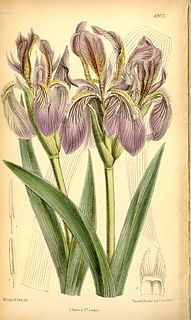
Typha latifolia is a perennial herbaceous plant in the genus Typha. It is found as a native plant species in North and South America, Europe, Eurasia, and Africa. In Canada, broadleaf cattail occurs in all provinces and also in the Yukon and Northwest Territories, and in the United States, it is native to all states except Hawaii. It is an introduced and invasive species, and is considered a noxious weed, in Australia and Hawaii. It has been reported in Indonesia, Malaysia, New Zealand, Papua New Guinea, and the Philippines.

Anubias is a genus of aquatic and semi-aquatic flowering plants in the family Araceae, native to tropical central and western Africa. They primarily grow in rivers and streams, but can also be found in marshes. They are characterized by broad, thick, dark leaves that come in many different forms. The genus was revised in 1979 and since then its nomenclature has been stable. Species can be determined by using mostly characteristics of the inflorescence. Because of the often shady places where the plants grow, the genus was named after the Egyptian god Anubis, the god of the afterlife. The genus was first described in 1857 by Heinrich Wilhelm Schott, with A. afzelii as its type species.

Lavandula angustifolia, formerly L. officinalis, is a flowering plant in the family Lamiaceae, native to the Mediterranean. Its common names include lavender, true lavender or English lavender ; also garden lavender, common lavender, and narrow-leaved lavender.

Fraxinus angustifolia, the narrow-leafed ash, is a species of Fraxinus native to central and southern Europe, northwest Africa, and southwest Asia.

Anubias barteri is a West African species of Anubias, first described in 1860 by Heinrich Wilhelm Schott. It occurs in south-eastern Nigeria, Cameroon and on Bioko.

Anubias barteri var. nana was first described by Adolf Engler in 1899 as A. nana. The species was reduced to varietal status in 1979.
Anubias gracilis is a plant that was first mentioned in 1920 by Chevalier and thereafter validly described by Hutchinson and Dalziel in 1936.

Persoonia lanceolata, commonly known as lance-leaf geebung, is a shrub native to New South Wales in eastern Australia. It reaches 3 m (10 ft) in height and has smooth grey bark and bright green foliage. Its small yellow flowers grow on racemes and appear in the austral summer and autumn, followed by green fleshy fruits which ripen the following spring. Within the genus Persoonia, P. lanceolata belongs to the lanceolata group of 58 closely related species. It interbreeds with several other species found in its range.

Anubias afzelii is a species belonging to the Aroid genus Anubias. It was first described scientifically by Heinrich Wilhelm Schott in 1857, based on material collected in Sierra Leone by Adam Afzelius, after whom the species was named. The genus Anubias was described simultaneously, with only A. afzellii belonging to it, which therefore is the type species of the genus. No other species currently placed in the genus Anubias was described earlier and A. afzelii was therefore the first species of this genus known to science.

Anubias heterophylla is a species belonging to the Aroid genus Anubias. It was first described scientifically by Adolf Engler in 1879.

Anubias barteri var. caladiifolia was first described by Adolf Engler in 1915.
Anubias barteri var. glabra is a variety of A. barteri that was first described by N. E. Brown in 1901.

Curcuma angustifolia is one of over 80 species belonging to the genus Curcuma, in the family Zingiberaceae. This species is native to the Indian subcontinent and is more commonly known as East Indian arrowroot or narrow-leaved turmeric in English, and is called "yaipan" in Manipuri, "Aipah" in Thadou-Kuki, "tikhur" in Hindi, and "Koova" കൂവ in Malayalam, and is called "Kutupah" in Poula. In the Eastern hemisphere, the plant plays an integral role in many cultures.
Anubias gigantea is a species belonging to the Aroid genus Anubias. It was first mentioned by Auguste Chevalier in 1920, based on material that he had collected in Guinea. The formal description followed in 1939 by John Hutchinson. It is closely related to A. afzelii, basically only differing from that species by the form of the leaf-blade.
Anubias gilletii is a plant that was first described scientifically in 1901 by Émile Auguste Joseph De Wildeman and Th. Durand.

Iris hookeriana is a plant species in the genus Iris, it is also in the subgenus Iris and in the section Pseudoregelia. It is a rhizomatous perennial, from the Himalayan mountains of India and Pakistan. It has long pale green or yellow green leaves, long slender stem and fragrant blue, purple or lilac flowers, that are mottled with a darker colour. It is cultivated as an ornamental plant in temperate regions.

Iris scariosa is a plant species in the genus Iris, it is also in the subgenus Iris. It is a rhizomatous perennial, from the mountainsides of Russia, Kazakhstan, Mongolia and China. It has sword-like, or sickle shaped, blue green or grey-green leaves, a short flowering stem, 3 or 4 membranous or semi-transparent flower bud leaves, 2 violet, reddish violet, lilac, blue-purple, or blue flowers in late spring, with yellow or white beards. It is cultivated as an ornamental plant in temperate regions. It was merged with another similar iris in the region, and Iris glaucescens became a synonym of Iris scariosa, before being divided into two separate species again. Although some sources still call it the main species, despite a slight colour difference.
Anubias pynaertii is a species belonging to the Aroid genus Anubias. It was first described scientifically by Émile Auguste Joseph De Wildeman in 1910, based on material collected in Zaire by, among others, Léon Auguste Edouard Joseph Pynaert, after whom the species was named.

Anubias hastifolia is a species belonging to the Aroid genus Anubias. It was first mentioned by Adolf Engler in 1889 and described scientifically by him in 1893.













